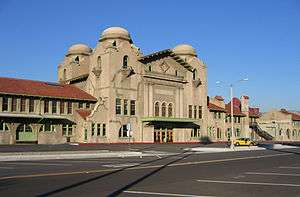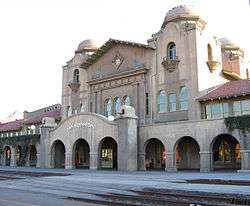Santa Fe Depot (San Bernardino)
San Bernardino | ||||||||||||||||||||||||||
|---|---|---|---|---|---|---|---|---|---|---|---|---|---|---|---|---|---|---|---|---|---|---|---|---|---|---|
 | ||||||||||||||||||||||||||
| Location |
1170 West Third Street San Bernardino, CA 92410[1] United States | |||||||||||||||||||||||||
| Coordinates | 34°06′15″N 117°18′35″W / 34.10417°N 117.30972°WCoordinates: 34°06′15″N 117°18′35″W / 34.10417°N 117.30972°W | |||||||||||||||||||||||||
| Owned by | San Bernardino Associated Governments | |||||||||||||||||||||||||
| Line(s) | BNSF Railway | |||||||||||||||||||||||||
| Platforms |
1 side platform (Amtrak) 3 island platforms (Metrolink) | |||||||||||||||||||||||||
| Tracks |
1 (Amtrak) 6 (Metrolink) | |||||||||||||||||||||||||
| Connections | Amtrak Thruway Motorcoach; 19A (to Hemet)[2] and 19B (to Indio)[3] | |||||||||||||||||||||||||
| Construction | ||||||||||||||||||||||||||
| Disabled access | Yes | |||||||||||||||||||||||||
| Other information | ||||||||||||||||||||||||||
| Station code | SNB (Amtrak) | |||||||||||||||||||||||||
| History | ||||||||||||||||||||||||||
| Opened | 15 July 1918 | |||||||||||||||||||||||||
| Rebuilt | 2004 | |||||||||||||||||||||||||
| Traffic | ||||||||||||||||||||||||||
| Passengers (2013) |
11,349[4] | |||||||||||||||||||||||||
| Services | ||||||||||||||||||||||||||
| ||||||||||||||||||||||||||
|
Atchison, Topeka and Santa Fe Railway Passenger and Freight Depot | ||||||||||||||||||||||||||
| Location | San Bernardino, California | |||||||||||||||||||||||||
| Built | 1918 | |||||||||||||||||||||||||
| Architect | W.A. Mohr; Cresmer Manufacturing Co. | |||||||||||||||||||||||||
| Architectural style | Mission Revival/Moorish Revival/Spanish Colonial Revival | |||||||||||||||||||||||||
| NRHP Reference # | [5] | |||||||||||||||||||||||||
| Added to NRHP | 2 February 2001 | |||||||||||||||||||||||||
| Location | ||||||||||||||||||||||||||
 San Bernardino Location within California | ||||||||||||||||||||||||||
The San Bernardino Santa Fe Depot is a Mission Revival Style passenger rail terminal in San Bernardino, California, United States. It currently serves one Amtrak (Southwest Chief) and two Metrolink lines (Inland Empire–Orange County Line and San Bernardino Line). The depot is a historical landmark listed on the National Register of Historic Places as Atchison, Topeka and Santa Fe Railway Passenger and Freight Depot.[6]
Early history
Through its subsidiary California Southern Railroad, the Atchison, Topeka and Santa Fe Railway (ATSF) first built a two-and-a-half-story wooden structure on the site in 1886 to replace a converted boxcar that had been used as a temporary station.[7] The 1886 building was mostly destroyed in a fire on 16 November 1916.[8]
Architecture and design

Local politicians requested ATSF to build a new station on a much larger scale than the previous. The new station, designed by architect W.A. Mohr, cost $800,000 (equivalent to $12,607,000 in 2015) to build and was officially opened on 15 July 1918. At that time, it was the largest railway station west of the Mississippi River. The San Bernardino Sun wrote "Santa Fe's Station to be the finest in the west." A few years after the depot's opening, an extension was added that included a Harvey House and living quarters.[8]
The historic depot is built in the Mission Revival Style with Moorish Revival and Spanish Colonial Revival features. Utilizing hollow clay blocks, a red tile roof and stucco exterior, the depot was designed to withstand fire. Four domed towers are built around a large center lobby with polished tile walls and floor. The interior includes handcrafted high beams, coffered ceilings and decorative column capitals.[8]
Decline and renovation
The station saw heavy use throughout the 20th century. But like with many railroad stations, there was a gradual decline in usage with the advent of automobiles, buses and air travel. The Harvey House closed in the 1950s. In 1971, ATSF transferred its passenger service to Amtrak. Metrolink began service to the station in the early 1990s.[9]

In 1992, San Bernardino Associated Governments (SANBAG) purchased the historic depot from Santa Fe. While Amtrak and Metrolink stopped using the depot in favor for a much smaller newer structure on the west side of the older one, SANBAG acquired over $15 million from federal and local grants and funds to begin an extensive restoration of the historic depot beginning in 2002. In 2004, SANBAG and Metrolink moved some of their offices there. After renovations are complete, SANBAG will share ownership with the City of San Bernardino and both agencies intend on leasing space in it.[10] The historic depot waiting area, along with a new snack shop, opened again for Amtrak and Metrolink passengers on 2 May 2008.[11] Greyhound Lines also planned on moving passenger operations to the depot at some point in 2009,[12] although as of 2016 that has not occurred.
Services
The San Bernardino station serves as the eastern terminus for most Metrolink San Bernardino Line trains which originate from Los Angeles' Union Station and the northern terminus for some Inland Empire-Orange County Line trains. Some San Bernardino Line trains continue southwestward towards Riverside on weekends.
San Bernardino is considered a 91 Line station, but no actual 91 Line (700-series) trains stop there. It is listed because the combination of the Orange County and IE-OC lines is listed on the 91-line timetable. When one transfers between the two in Orange, the effect is the same as riding the 91 Line.
Amtrak's Southwest Chief, which travels between Los Angeles, California and Chicago, Illinois, stops once a day in each direction here.
There are no ticket offices at the station, though tickets for both Amtrak and Metrolink can be picked up at Metrolink's ticket vending machines. Amtrak tickets must be reserved either via telephone or internet before being picked up.
Platforms and tracks
| Amtrak platform | ■ Southwest Chief | toward Los Angeles (Riverside–Downtown) |
| ■ Southwest Chief | toward Chicago (Victorville) | |
| Metrolink platforms | ■ Inland Empire–Orange County Line | toward Oceanside (Riverside–Downtown) |
| ■ San Bernardino Line | toward L.A. Union Station (Rialto) |
Former services
| Former services | ||||
toward Los Angeles | Desert Wind Discontinued in 1997 | toward Chicago |
||
| Atchison, Topeka, and Santa Fe | ||||
toward Los Angeles | Main Line | Cajon toward Chicago Dearborn Station |
||
Major stations toward Los Angeles | Major stations toward Chicago Dearborn Station |
|||
toward Los Angeles | Main Line | Cajon toward Chicago Dearborn Station |
||
Major stations toward Los Angeles | Major stations toward Chicago Dearborn Station |
|||
| Terminus | Redlands Loop | Redlands Terminus |
||
Arrowhead toward Redlands |
||||
toward San Jacinto | San Jacinto Branch | Terminus | ||
References
- ↑ "San Bernardino, CA (SNB)". amtrak.com. Amtrak. Retrieved 11 Jan 2014.
- ↑ Amtrak Thruway Bus Route 19a; Bakersfield - Hemet (Amtrak California)
- ↑ Amtrak Thruway Bus Route 19b; Bakersfield - Indio (Amtrak California)
- ↑ "Great American Stations: San Bernardino, CA (SNB)". greatamericanstations.com. Amtrak. Retrieved 27 Nov 2012.
- ↑ National Park Service (2008-04-15). "National Register Information System". National Register of Historic Places. National Park Service.
- ↑ "California - San Bernardino County". www.nationalregisterofhistoricplaces.com. American Dreams, Inc. Retrieved 11 Jan 2014.
- ↑ Serpico, Philip C. (1988). Santa Fé Route to the Pacific. Palmdale, California: Omni Publications. p. 20. ISBN 0-88418-000-X.
- 1 2 3 "A Brief History of the Santa Fe Depot". San Bernardino Associated Governments. Retrieved 11 Jan 2014.
- ↑ "SANBAG Property Acquisition, Depot Restoration Funding". San Bernardino Associated Governments. Retrieved 11 Jan 2014.
- ↑ "Restoration Details". San Bernardino Associated Governments. Retrieved 11 Jan 2014.
- ↑ Richard, Chris (4 Mar 2008). "San Bernardino depot is open for rail travelers, thanks to historical society volunteers". The Press-Enterprise. Riverside, California: Freedom Communications.
- ↑ Gaudette, Karen; Santos, K. Franke (13 Jul 2003). "Polishing a Jewel of a Depot". www.harveyshouses.net. TrainWeb LLC. Retrieved 11 Jan 2014. Copied from original article in The Press-Enterprise
External links
 Media related to Santa Fe Depot (San Bernardino) at Wikimedia Commons
Media related to Santa Fe Depot (San Bernardino) at Wikimedia Commons
- Metrolink – San Bernardino
- San Bernardino Amtrak Station (USA Rail Guide -- TrainWeb)
- San Bernardino (SNB)--Great American Stations (Amtrak)
